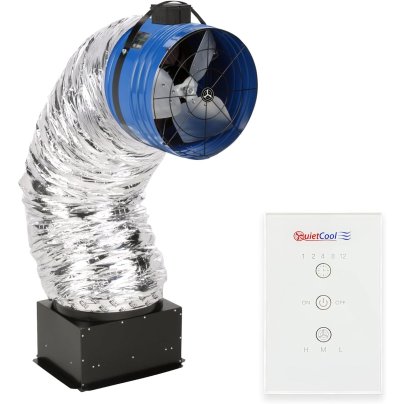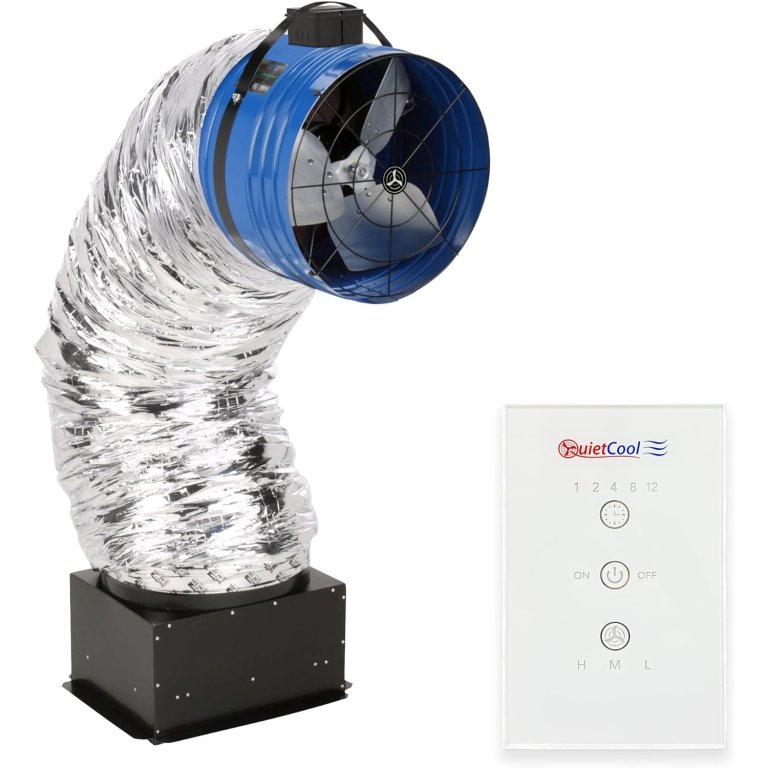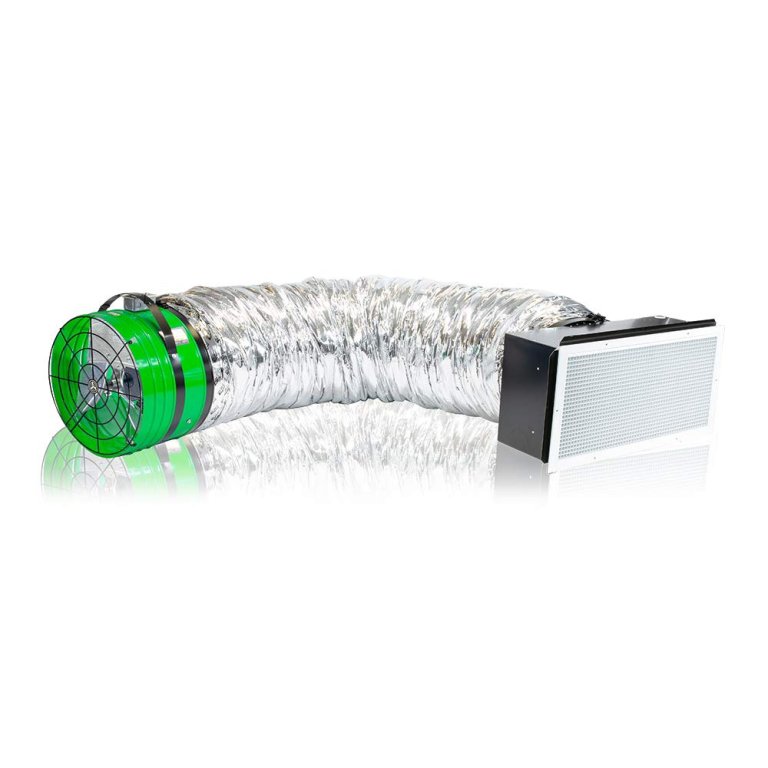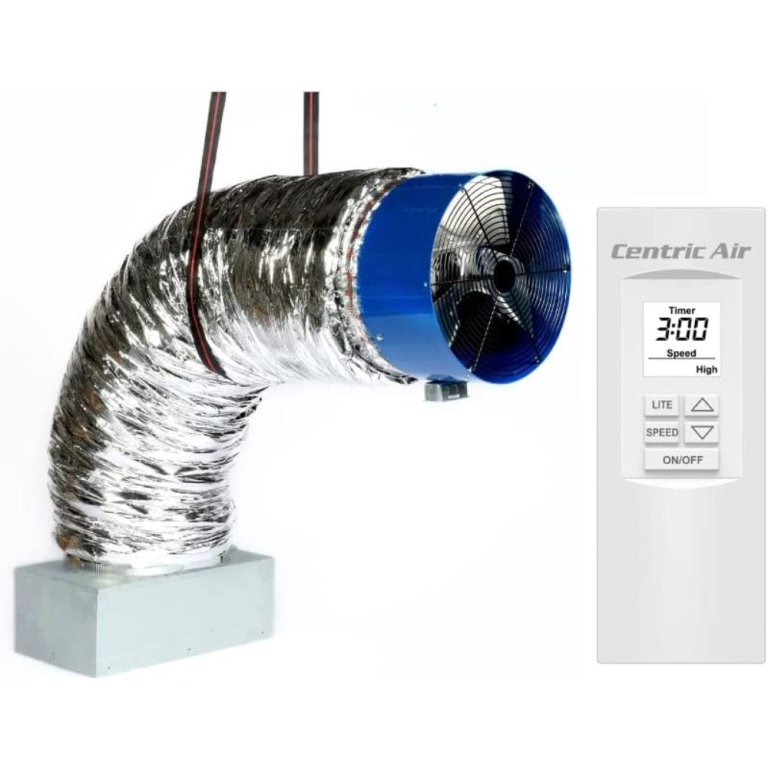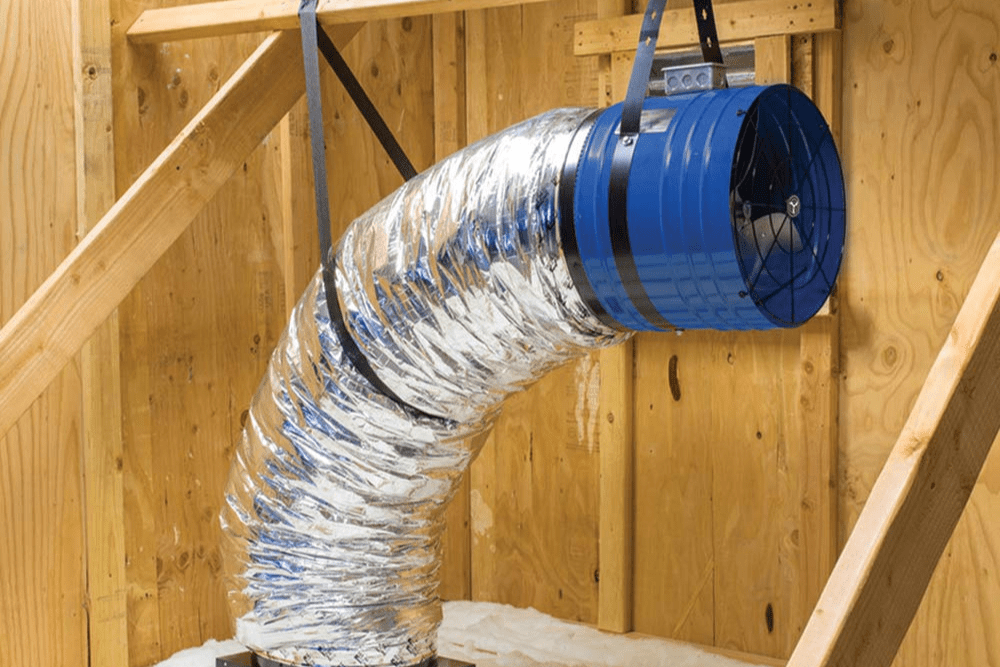
We may earn revenue from the products available on this page and participate in affiliate programs. Learn More ›
Central air, window air conditioners, and split AC units aren’t the only ways to keep a home comfortable during hotter weather: a whole house fan consumes less energy and provides a bit more fresh air while keeping temperatures in check.
A whole-house fan is installed in the upper level of a home. It draws in the fresh air and ejects the warm, stale air through a vent in the attic. The result is fresher air and more comfortable temperatures indoors while potentially lowering the electric bill (due to running the heating and cooling system less). We recommend the QuietCool ES-4700 Energy Saver Whole House Fan as our best overall pick because of its 2,280 cubic feet per minute (CFM) flow of air that can deliver fast cooling for spaces up to 1,200 square feet. We also found quality options for those who need more cooling power for large spaces or are working with a tighter budget. To bolster our research, we interviewed an HVAC expert for key shopping insights. We also tested one of the products ourselves. Keep reading to learn more about which of the best whole-house fans is a good fit for your home.
- BEST OVERALL: QuietCool QC CL-2250 Advanced Whole House Fan
↓ Jump to Review - BEST BANG FOR THE BUCK: Maxx Air Cool Attic Direct-Drive Whole House Fan
↓ Jump to Review - UPGRADE PICK: QuietCool ES-4700 Energy Saver Whole House Fan
↓ Jump to Review - BEST DIRECT-DRIVE: QA-Deluxe Wireless Remote Control Whole House Fan
↓ Jump to Review - BEST WINDOW FAN: Air King 9166F 20-Inch Whole House Window Fan
↓ Jump to Review - ALSO CONSIDER: Air Vent Gable Ventilator Attic and Whole House Fan
↓ Jump to Review
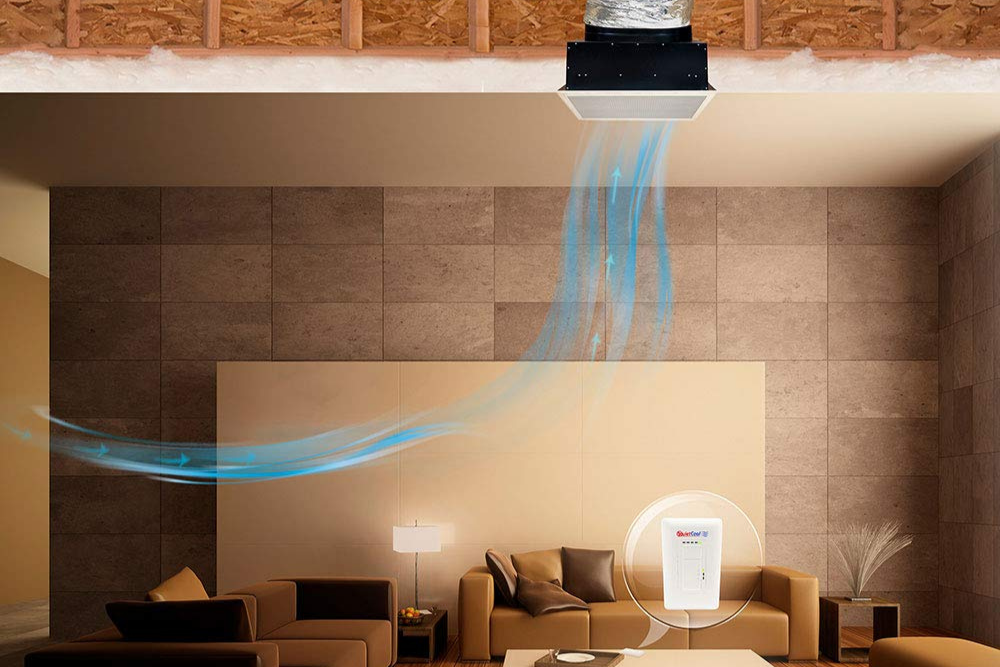
Whole House Fans Comparison Chart
| Type | CFM | Remote Control | |
| QuietCool QC CL-2250 Advanced Whole House Fan | Ducted | 1770 to 2495 | Yes |
| Maxx Air Cool Attic Direct-Drive Whole House Fan | Attic fan | Up to 2,985 | No |
| QuietCool ES-4700 Energy Saver Whole House Fan | Ducted | 2,304 to 4,195 | Yes |
| QA-Deluxe Wireless Remote Control Whole House Fan | Ducted | 3,945 | Yes, wireless remote controller with timer |
| Air King 9166F 20-Inch Whole House Window Fan | Window fan | 2,510 to 3,560 | No remote control or Wi-Fi |
| Air Vent Gable Ventilator Attic and Whole House Fan | Gable fan | 1,050 | No; it comes with a programmable thermostat |
Our Top Picks
There is a lot to think about when shopping for the best whole-house fan, but choosing one needn’t be complicated or time-consuming. Those in the market for one of these fans will want to consider the following top picks, which are among the best whole-house fans on the market. Whether hunting for a ducted fan or a more basic model, you’ll be sure to find some good options for everyone among these leading fans for cooling bathrooms, bedrooms, kitchens, and other indoor spaces.
Best Overall
QuietCool QC CL-2250 Advanced Whole House Fan
What We Like
- Simple installation; no framing required
- Makes a room feel cooler in minutes
- Ideal for stuffy bedrooms or living rooms
- Offers quiet operation
What We Don’t Like
- Only covers 1,233 square feet
Specs
- Type: Ducted
- CFM: 1770 to 2495
- Remote Control: Yes
With two speeds and a maximum airflow of 2,495 CFM, the QuietCool QC CL-2250 Advanced Whole House Fan is a great solution for cooling down the hottest rooms in the house without relying on energy-sucking AC units. This model can effectively ventilate spaces up to 1,233 square feet, making it ideal for small homes or use in large living rooms or bedrooms.
This QuietCool whole house fan features a simple installation process that doesn’t require framing or cutting of joists. Instead, its fan motor head hangs from the attic rafter, and a small ceiling cutout is needed for the intake grill. QuietCool estimates that complete installation can be finished in 1 to 2 hours. We also like the fact that the fan comes with a remote that allows users to select the speed, turn the fan on or off, and set a timer.
Get the QuietCool whole house fan at Amazon, The Home Depot, or Walmart.
Best Bang For The Buck
Maxx Air Cool Attic Direct Drive Whole House Fan
What We Like
- Affordable whole-house fan
- Comes with a white automatic shutter
- Features joist-in or joist-out installation
- Suitable for mid-to-large-sized attics
What We Don’t Like
- No remote included
Specs
- Type: Attic fan
- CFM: Up to 2,985
- Remote Control: No
Those looking to supplement their air conditioning use and increase air ventilation in the home may want to check out the more affordably priced Maxx Air. This whole-house exhaust fan is suitable for 1,200- to 1,800-square-foot attics and can produce a maximum airflow of up to 2,985 CFM.
The Maxx Air features joist-in or joist-out installation, two speeds, and a wall-mounted on-and-off whole-house fan switch. This fan has a direct-drive motor type and steel housing case. It also comes with an automatic shutter in a powder-coated white finish to blend in with the ceiling.
Get the Maxx Air whole house fan at Lowes or The Home Depot.
Upgrade Pick
QuietCool ES-4700 Energy Saver Whole House Fan
What We Like
- Features an efficient brushless motor
- Barometric pressure dampers stay closed when not used
- Features a wall-mounted remote
- Remote works from up to 100 feet away
What We Don’t Like
- May not be suitable for large homes
Specs
- Type: Ducted
- CFM: 2,304 to 4,195
- Remote control: Yes
Sometimes, spending a little extra now saves money in the long run. QuietCool’s ES-4700 might cost more than the company’s other units, but this series’ brushless direct-drive motors are efficient, quiet, and require minimal maintenance.
The QuietCool ES-4700 is a ducted fan unit with a dampened vent for temperature control and comfort. The ES line comes in sizes ranging from 1,434 CFM to 6,878 CFM for cooling homes from 700 square feet to over 3,000 square feet, while the ES-4700 produces 4,195 CFM (2,304 CFM on low) for homes up to 2,295 square feet. This QuietCool unit’s damper system features barometric-pressurized gravity activation to retain heated or cooled air, helping this model improve efficiency even further. It also comes with a wall-mounted remote control that can operate the fan from up to 100 feet away.
Get the QuietCool ES-4700 whole-house fan at Amazon or The Home Depot.
Best Direct-Drive
QA-Deluxe Wireless Remote Control Whole House Fan
What We Like
- Direct-drive motor allows for quiet operation
- Louvered grill shuts when fan not in use
- Insulated duct further improve noise reduction
What We Don’t Like
- No Wi-Fi interface for smart operation
Specs
- Type: Ducted
- CFM: 3,945 CFM
- Remote control: Yes, wireless remote controller with timer
Folks shopping for a quality direct-drive fan that will offer low maintenance and very little noise might want to take a look at the QA-Deluxe. This quiet whole-house fan has an efficient direct-drive motor with two speeds, producing up to 3,945 CFM of airflow in homes up to 3,400 square feet.
The QA-Deluxe has more features worth noting. The fan sits at the end of an insulated duct to minimize noise, and the other end boasts a louvered grill that shuts when the fan is not in use. It also has a two-speed remote control that allows for wireless adjustments. It also features rubber bushings to reduce noise and vibration even further. Unfortunately, “wireless” does not mean Wi-Fi—there isn’t an app to control this fan from a phone or tablet.
Get the QA-Deluxe whole-house fan at Amazon, The Home Depot, or QA-Deluxe Fans.
Best Window Fan
Air King 9166F 20-Inch Whole House Window Fan
What We Like
- Fits windows between 27 and 38 inches wide
- Storm Guard keeps inclement weather out
- Can be removed from a window at anytime
What We Don’t Like
- Doesn’t include a remote control or Wi-Fi control
Specs
- Type: Window fan
- CFM: 2,510 to 3,560 CFM
- Remote control: No remote control or Wi-Fi
When you want home ventilation but don’t want to mess with a complicated attic installation, a portable whole-house exhaust fan presents an easy solution. This Air King model can fit in any window opening that is 27 to 38 inches wide and 26.5 inches high. Simply place the fan in the window, adjust the sliders, and shut the window on top of the fan to secure it.
Three fan settings allow you to adjust the circulation, and a storm guard enables you to close the window on the back of the fan during inclement weather. While this model is a little pricey for a window fan, it offers powerful circulation of up to 3,560 CFM on its highest setting.
What our tester says: Stacey Nash, a Bob Vila writer and product tester, notes in The Best Window Fans that “we can attest to the power of this Air King fan. During testing, there was an unfortunate accident on the stove that left behind some seriously unpleasant odors. We turned this fan on exhaust, and the house was cleared of odors within 10 minutes. It’s heavy and loud but powerful. It was tested in a 2,318-square-foot home, and we could feel cool air moving in almost every room, going beyond the advertised 1,310 square feet.”
Get the Air King whole-house fan at Amazon or Walmart.
Also Consider
Air Vent Gable Ventilator Attic and Whole House Fan
What We Like
- Affordable method for ejecting hot air from attics
- Housing design consists of rings to improve efficiency
- Comes with a programmable thermostat
- Thermostat activates the fan automatically
What We Don’t Like
- Users must purchase their own louvers or vent
- Doesn’t offer Wi-Fi connectivity or a remote control
Specs
- Type: Gable fan
- CFM: 1,050 CFM
- Remote control: No; it comes with a programmable thermostat
Folks hoping to move air through their homes or simply eject it from their hot attics might find the Air Vent Gable Ventilator an excellent solution. This model features a direct-drive motor that Air Vent states is 30 percent quieter and 35 percent more efficient than comparable fans while also remaining affordable—a trait that we appreciate.
This Air Vent fan features a unique design. Rather than sitting within a solid shroud, the fan fits inside a series of rings to allow more airflow with less restriction and improve efficiency. It operates as a 1,050 CFM whole-house attic fan, making it suitable for attics up to 1,500 square feet. Unfortunately, it doesn’t come with a set of louvers or a vent, so you’ll want to purchase these separately. While it doesn’t include a remote control, there is a programmable thermostat.
Get the Air Vent whole-house fan at Amazon or Lowes.
Jump to Our Top Picks

How We Chose the Best Whole-House Fans
Choosing a list of the best whole-house fans wasn’t easy breezy. We wanted to ensure that every fan we suggested could really make a difference by cooling homes. For that reason, we drew upon all of our DIY and home improvement experience, as well as some heating, proper ventilation, and air conditioning experience, to determine the most important features and components a fan should have. We also hands-on tested one of these products to make sure it was up to snuff.
Once we knew what to look for, we performed extensive product research to compile a list of the best fans we thought would meet our criteria. We then compared these fans’ power, design, and prices to ensure they offered enough value to make our lineup. Those that didn’t were cut, while those that did were given awards based on their strengths.
What to Consider When Choosing a Whole-House Fan
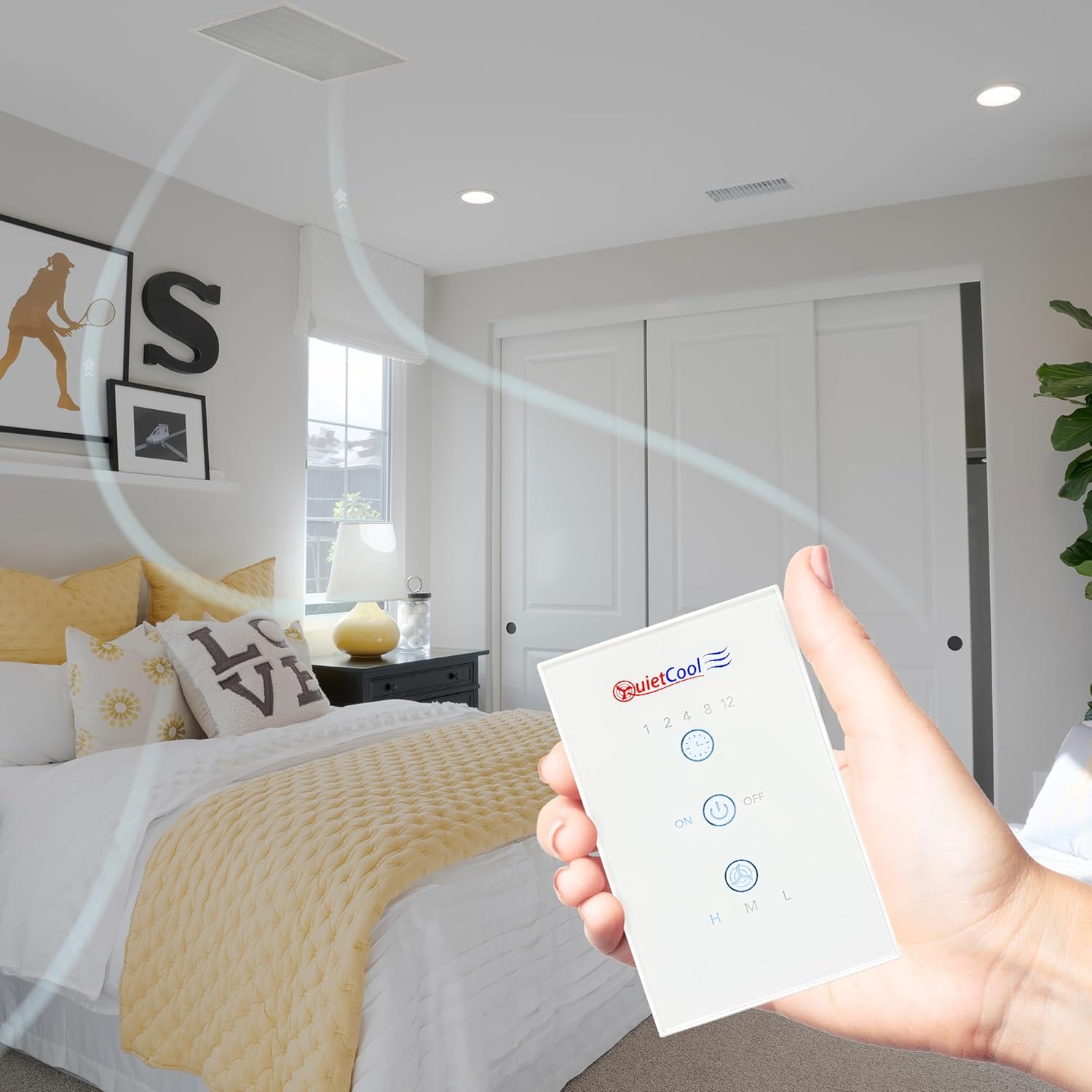
There’s a lot to know about choosing the best whole-house fan system for bedrooms, living rooms, and more, but shoppers shouldn’t lose their cool. The following sections will outline the most important considerations to keep in mind when shopping for the most efficient whole-house fan to cool an entire home.
Type
There are four main types of whole-house fans, and they differ in several ways.
- Standard whole-house fans look a lot like typical box fans or floor fans, but they are installed in the walls or floors of attics or other upper-level rooms. These fans have louvers or insulated dampers that remain closed when the fan is not in use but open to allow the fan to push interior air outside.
- Ducted whole-house fans have long, insulated ducts with a finished vent on one side and a large fan on the other. The fan is installed in an attic or knee wall, and the duct goes into the finished space to be cooled by the fan. Ducted fans are the quietest fans of the three options because the fan is typically more than 10 feet away from the finished space that it cools.
- Insulated door whole-house fans are generally designed to be installed in an attic floor. They have heavily insulated doors that remain shut when the fan is off but are open when it’s in use.
- Gable fans are designed to be installed in gable-end walls, typically toward the peak where the two roof planes meet. These attic fans are usually simple, direct-drive fans with a thermostat. While they can be rather loud, they are typically effective at pulling air into the home from the lower floors and ejecting hot air from the attic.
Once a homeowner decides on the type of fan that’s best for their needs, the next decision is whether to get a direct-drive or belt-drive fan. Direct-drive fans have motors mounted directly to the fan blade (somewhat similar to a ceiling fan or box fan). Belt-driven fans are standard whole-house fans with separate motors, with belts connecting the motors to the fans. Direct-drive fans are typically the most energy-efficient, but belt-driven fans are quieter.
Size and CFM
Whole-house ventilation fans are available in different sizes and airflow ratings, and it’s important to choose one that will work for your home. Installing a small fan in a large house won’t pull cooler air into the space effectively, and installing a large fan in a small home might feel like living in a wind tunnel.
In their product literature, most manufacturers will indicate the size of the home for which their fans are suitable. They might also list the CFM, which describes the volume of air that the fan can move. The square footage of the living space determines the CFM a fan should have:
- 2,000 CFM whole-house fans are suitable for smaller homes and apartments under 1,000 square feet.
- 3,000 CFM whole-house fans are suitable for homes around 1,500 square feet.
- 4,000 CFM whole-house fans are best for homes around 2,000 square feet.
- 5,000 CFM whole-house fans work for homes with 2,500 square feet of living space.
- For homes over 3,000 square feet, a 6,000 to 7,000 CFM whole-house fan will do the trick.
Noise Level
“Nobody wants a noisy, bothersome fan, therefore, noise levels are an important consideration when deciding between direct-drive and belt-drive whole-house fans,” says Jordan Benjamin, President of Done Rite Services, an HVAC, Plumbing, and Electrical company in Tucson, Arizona. For those who are sensitive to noise, some fans are better choices than others.
The quietest whole-house fan option is the ducted type—by a long shot. Because the actual fan is on the end of a long duct and installed in a separate space, home occupants will hear very little noise. These are quieter than standard window fans.
The second-quietest option is a belt-driven standard model. “The belt functions as a buffer, lowering motor noise and allowing for more efficient operation. If your bedroom is close to the fan site or you are sensitive to noise, a belt-drive fan may be a better choice,” says Benjamin.
Remote Control and Additional Features
Whole-house fans are convenient, but some are easier to use than others. Many models have built-in timers or temperature switches that can be programmed to turn on automatically. Others have convenient remote controls.
Some fans have Wi-Fi connectivity so that they can be controlled via a smartphone app. With these fans, you don’t even have to be home to ensure the temperature in the house is comfortable. You can adjust fan speed, timers, and other settings directly from your phone.
If the whole-house fan chosen is not W-iFi enabled, there’s a work-around: Simply install a WiFi-enabled switch to control the fan and provide remote connectivity. While these switches might not provide the same functionality as a specific app, a simple on/off switch you can control from anywhere can make a world of difference when it comes to comfort.
FAQs
Despite the information presented here, there may still be questions about how these fans work. Read on for answers to some of the most common questions about whole-house fans.ons about how they work. Read on for answers to some of the most common questions about whole-house fans.
The best whole-house fans are reportedly 50 to 90 percent more efficient than most central air conditioners, which means that users can reduce their cooling costs by up to 90 percent each month.
They’re effective at cooling when the exterior temperature is lower than the temperature inside the home. The airflow these fans create can make a space much more comfortable, even if it doesn’t lower the temperature inside very much.
It depends on the size of the home and its design, but some general guidelines are:
2,000 CFM for homes under 1,000 square feet
3,000 CFM for 1,500 square feet
4,000 CFM for 2,000 square feet
5,000 CFM for 2,500 square feet
6,000 to 7,000 CFM for homes more than 3,000 square feet
Yes. During hotter months, nighttime is actually the best time to run a whole-house ventilator fan for home cooling. You can also install a timer or a Wi-Fi switch if you’d prefer to schedule when the fan runs.
Some WiFi-enabled fans are available, but many come with simple remote controls. If you’d prefer to operate a non-app-controlled fan via your smartphone, you can install a WiFi-enabled switch.
Direct-drive motors don’t require much maintenance—just ensure that the fan is clean and unobstructed. Belt-driven fans will require new belts every few years, depending on usage. Check the manufacturer’s instructions for specifics on your model.
An attic or whole-house fan is a very simple design, and users can expect to get around 15 years of use from a fan before having to replace it.
